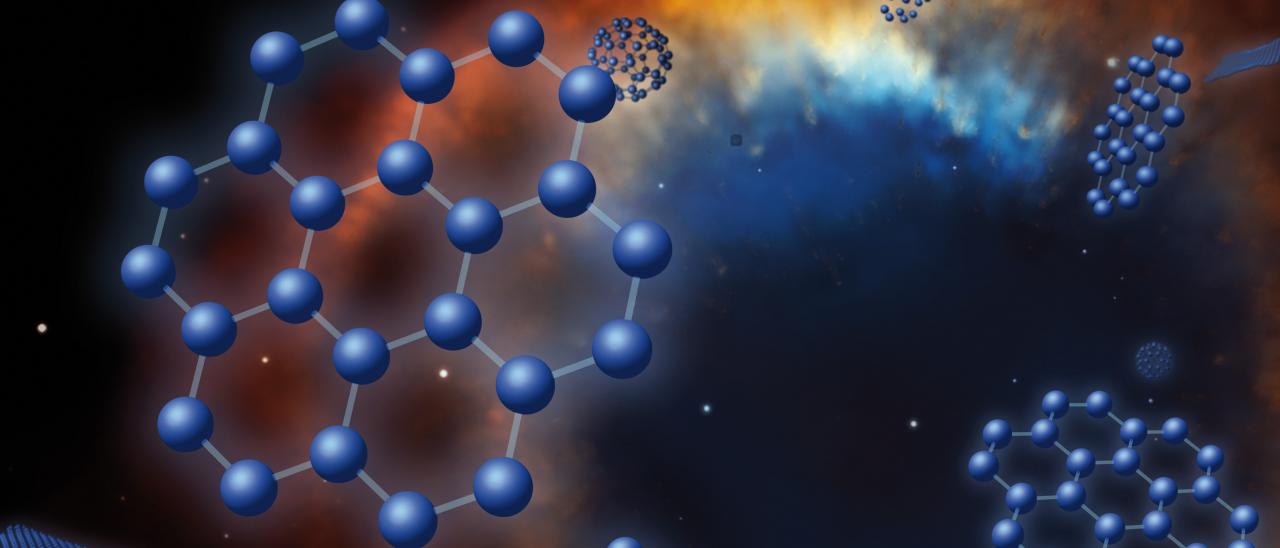Subvenciones relacionadas:
General
Las estrellas de masa baja e intermedia (M < 8 masas solares, Ms) representan la mayoría de estrellas en el Cosmos y terminan sus vidas en la Rama Asintótica de las Gigantes (AGB) - justo antes de formar Nebulosas Planetarias (NPs) - cuando experimentan procesos nucleosintéticos y moleculares complejos. Las estrellas AGB son importantes contribuyentes al enriquecimiento del medio interestelar, donde nacen nuevas estrellas y planetas (incluyendo nuestro propio Sistema Solar Temprano, SST) y a la evolución química de sistemas estelares como cúmulos globulares (CGs) y galaxias. En particular, las AGBs más masivas (M > 4-5 Ms) sintetizan (radio)isótopos muy diferentes de los formados por AGBs menos masivas y explosiones de Supernova debido a los diferentes mecanismos de nucleosíntesis. Las estrellas evolucionadas en la fase de transición entre AGBs y NPs también forman diversos compuestos orgánicos como PAHs y nanoestructuras moleculares de fullereno y grafeno, siendo un maravilloso laboratorio Astroquímico. Colaboraciones astronómicas punteras como SDSS-IV/APOGEE-2 y el próximo telescopio espacial James Webb representan un paso fundamental para entender la nucleosíntesis y los procesos moleculares en estrellas evolucionadas. Se pretende explorar la nucleosíntesis de (radio)isótopos ligeros/pesados en estrellas AGB y como éstas contribuyen a la radioactividad del SST así como a la formación/evolución de CGs y galaxias. También se pretende entender el proceso de formación "top-down" de nanoestructuras moleculares de fullereno y grafeno en estrellas evolucionadas. Finalmente, se pretende realizar minería de datos obtenidos con el satélite Gaia, para estudiar la fase evolutiva AGB-NP, y además utilizar el telescopio espacial GALEX para descubrir estrellas binarias en NPs Galácticas.
Miembros
Resultados
1. Durante 2020, se han publicado 37 artículos en revistas astronómicas internacionales con referee de alto impacto (incluyendo un review invitado), así como 2 artículos en la revista de Química-Física FNCN.
2. Se han descubierto, por primera vez, estrellas muy ricas en fósforo y cuyo patrón químico no es predicho por ninguna teoría actual de nucleosíntesis estelar.
3. Se ha demostrado que las estrellas ricas en fósforo representan un nuevo sitio estelar para la formación de elementos muy pesados, con importantes implicaciones para la evolución química de nuestra Galaxia.
Actividad científica
Publicaciones relacionadas
-
Oxygen Isotopic Ratios in Cool R Coronae Borealis StarsWe investigate the relationship between R Coronae Borealis (RCB) stars and hydrogen-deficient carbon (HdC) stars by measuring precise 16O/18O ratios for five cool RCB stars. The 16O/18O ratios are derived by spectrum synthesis from high-resolution (R ~ 50, 000) K-band spectra. Lower limits to the 16O/17O and 14N/15N ratios as well as Na and SGarcía-Hernández, D. A. et al.
Fecha de publicación:
52010 -
Outburst activity in comets - II. A multiband photometric monitoring of comet 29P/Schwassmann-Wachmann 1We have carried out a continuous multiband photometric monitoring of the nuclear activity of comet 29P/Schwassmann-Wachmann 1 from 2008 to 2010. Our main aim has been to study the outburst mechanism on the basis of a follow-up of the photometric variations associated with the release of dust. We have used a standardized method to obtain the 10Trigo-Rodríguez, Josep M. et al.
Fecha de publicación:
122010 -
New groups of planetary nebulae with peculiar dust chemistry towards the Galactic bulgeAims: We investigate Galactic bulge planetary nebulae without emission-line central stars for which peculiar infrared spectra have been obtained with the Spitzer Space Telescope, including the simultaneous signs of oxygen and carbon based dust. Three separate sub-groups can be defined characterized by the different chemical composition of the dustGórny, S. K. et al.
Fecha de publicación:
62010 -
Heavy Element Nucleosynthesis in the Brightest Galactic Asymptotic Giant Branch StarsWe present updated calculations of stellar evolutionary sequences and detailed nucleosynthesis predictions for the brightest asymptotic giant branch (AGB) stars in the Galaxy with masses between 5 M &sun; and 9 M &sun;, with an initial metallicity of Z = 0.02 ([Fe/H] = 0.14). In our previous studies we used the Vassiliadis & Wood mass-loss rateKarakas, Amanda I. et al.
Fecha de publicación:
52012 -
Evolution of tidal disruption candidates discovered by XMM-NewtonContext: It has been demonstrated that active galactic nuclei are powered by gas accretion onto supermassive black holes located at their centres. The paradigm that the nuclei of inactive galaxies are also occupied by black holes was predicted long ago by theory. In the past decade, this conjecture was confirmed by the discovery of giant-amplitudeEsquej, P. et al.
Fecha de publicación:
102008 -
CNO Abundances of Hydrogen-Deficient Carbon and R Coronae Borealis Stars: A View of the Nucleosynthesis in a White Dwarf MergerWe present high-resolution (R ~ 50, 000) observations of near-IR transitions of CO and CN of the five known hydrogen-deficient carbon (HdC) stars and four R Coronae Borealis (RCB) stars. We perform an abundance analysis of these stars by using spectrum synthesis and state-of-the-art MARCS model atmospheres for cool hydrogen-deficient stars. OurGarcía-Hernández, D. A. et al.
Fecha de publicación:
52009 -
Are C60 Molecules Detectable in Circumstellar Shells of R Coronae Borealis Stars?The hydrogen-poor, helium-rich, and carbon-rich character of the gas around R Coronae Borealis (RCB) stars has been suggested to be a site for formation of C60 molecules. This suggestion is not supported by observations reported here showing that infrared transitions of C60 are not seen in a large sample of RCB stars observed with the InfraredGarcía-Hernández, D. A. et al.
Fecha de publicación:
32011 -
A search for diffuse bands in the circumstellar envelopes of post-AGB starsIn this work we present the results of a systematic search for diffuse bands (DBs, hereafter) in the circumstellar envelopes of a carefully selected sample of post-AGB stars. We concentrated on analyzing 9 of the DBs most commonly found in the interstellar medium. The strength of these features is determined using high-resolution opticalLuna, R. et al.
Fecha de publicación:
32008 -
The role of massive AGB stars in the early solar system compositionWe demonstrate that a massive asymptotic giant branch (AGB) star is a good candidate as the main source of short-lived radionuclides in the early solar system. Recent identification of massive (4-8 M?) AGB stars in the galaxy, which are both lithium- and rubidium-rich, demonstrates that these stars experience proton captures at the base of theTrigo-Rodríguez, J. M. et al.
Fecha de publicación:
72009 -
The Nature of Dust in Compact Galactic Planetary Nebulae from Spitzer SpectraWe present the Spitzer/Infrared Spectrograph (IRS) spectra of 157 compact Galactic planetary nebulae (PNe). These young PNe provide insight on the effects of dust in early post-asymptotic giant branch evolution, before much of the dust is altered or destroyed by the hardening stellar radiation field. Most of the selected targets have PN-type IRSStanghellini, Letizia et al.
Fecha de publicación:
72012 -
The Intergalactic Stellar Population from Mergers of Elliptical Galaxies with Dark Matter HalosWe present simulations of dry-merger encounters between pairs of elliptical galaxies with dark matter halos. The aim of these simulations is to study the intergalactic (IG) stellar populations produced in both parabolic and hyperbolic encounters. We model progenitor galaxies with total-to-luminous mass ratios MT /M L= 3 and 11. The initial mass ofGonzález-García, A. Cesar et al.
Fecha de publicación:
22010 -
The Interaction of Asymptotic Giant Branch Stars with the Interstellar MediumWe study the hydrodynamical behavior of the gas expelled by moving asymptotic giant branch stars interacting with the interstellar medium (ISM). Our models follow the wind modulations prescribed by stellar evolution calculations, and we cover a range of expected relative velocities (10-100 km s-1), ISM densities (between 0.01 and 1 cm-3), andVillaver, Eva et al.
Fecha de publicación:
42012 -
The chemical composition of the post-asymptotic giant branch F supergiant CRL 2688We present an analysis of a high-resolution (R ˜ 50 000) optical spectrum of the central region of the protoplanetary nebula CRL 2688. This object is thought to have recently moved off the asymptotic giant branch (AGB) and displays abundance patterns of CNO and heavy elements that can provide us with important clues to help us understand theIshigaki, Miho N. et al.
Fecha de publicación:
92012 -
Rb-Rich Asymptotic Giant Branch Stars in the Magellanic CloudsWe present high-resolution (R ~ 60,000) optical spectra of a carefully selected sample of heavily obscured and presumably massive O-rich asymptotic giant branch (AGB) stars in the Magellanic Clouds. We report the discovery of strong Rb I lines at 7800 Å in four Rb-rich LMC stars at luminosities equal to or greater than the standard adoptedGarcía-Hernández, D. A. et al.
Fecha de publicación:
112009 -
Kinematical Analysis of a Sample of Bipolar Planetary NebulaeWe present the kinematics of a sample of bipolar planetary nebulae (PNs) which cover a wide range of observed morphologies and collimation degrees, from bipolar PNs (BPNs) with a marked equatorial ring and wide lobes to highly collimated objects. We use an empirical model in order to derive the expansion velocity, collimation degree, andDobrinčić, Martina et al.
Fecha de publicación:
62008 -
IRAS 17423-1755 (Hen 3-1475) Revisited: An O-rich High-mass Post-asymptotic Giant Branch StarThe high-resolution (R ~ 600) Spitzer/IRS spectrum of the bipolar protoplanetary nebula (PN) IRAS 17423-1755 is presented in order to clarify the dominant chemistry (C-rich versus O-rich) of its circumstellar envelope as well as to constrain its evolutionary stage. The high-quality Spitzer/IRS spectrum shows weak 9.7 μm absorption from amorphousManteiga, M. et al.
Fecha de publicación:
32011 -
High-resolution spectroscopy of the high-velocity hot post-AGB star LS III +52°24 (IRAS 22023+5249)The first high-resolution (R˜ 50 000) optical spectrum of the B-type star, LS III +52°24, identified as the optical counterpart of the hot post-asymptotic giant branch (post-AGB) candidate IRAS 22023+5249 (I22023) is presented. We report the detailed identifications of the observed absorption and emission features in the full wavelength range (4290Sarkar, G. et al.
Fecha de publicación:
32012 -
Formation of Fullerenes in H-containing Planetary NebulaeHydrogen depleted environments are considered an essential requirement for the formation of fullerenes. The recent detection of C60 and C70 fullerenes in what was interpreted as the hydrogen-poor inner region of a post-final helium shell flash planetary nebula (PN) seemed to confirm this picture. Here, we present strong evidence that challenges theGarcía-Hernández, D. A. et al.
Fecha de publicación:
112010 -
Far-infrared Imaging of Post-asymptotic Giant Branch Stars and (Proto)-planetary Nebulae with the AKARI Far-Infrared SurveyorBy tracing the distribution of cool dust in the extended envelopes of post-asymptotic giant branch stars and (proto)-planetary nebulae ((P)PNe), we aim to recover, or constrain, the mass-loss history experienced by these stars in their recent past. The Far-Infrared Surveyor (FIS) instrument on board the AKARI satellite was used to obtain farCox, N. L. J. et al.
Fecha de publicación:
42011 -
A Detailed look at Chemical Abundances in Magellanic Cloud Planetary Nebulae. I. The Small Magellanic CloudWe present an analysis of elemental abundances of He, N, O, Ne, S, and Ar in Magellanic Cloud planetary nebulae (PNe) and focus initially on 14 PNe in the Small Magellanic Cloud (SMC). We derive the abundances from a combination of deep, high-dispersion optical spectra, as well as mid-infrared (IR) spectra from the Spitzer Space Telescope. AShaw, Richard A. et al.
Fecha de publicación:
72010



